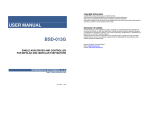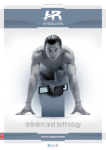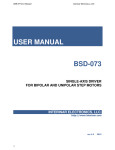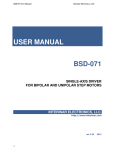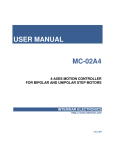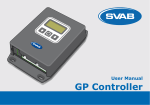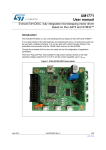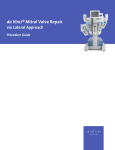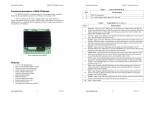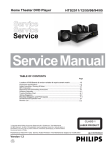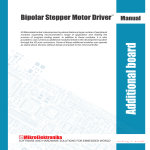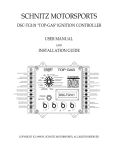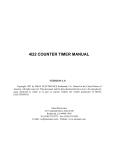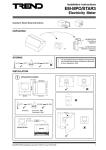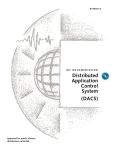Download USER MANUAL BSD-016
Transcript
Copyright Information © 2006-2012 Interinar Electronics,LLC. All rights reserved. This document is furnished exclusively for the customers of Interinar Electronics. Other uses are unauthorized without written permission of Interinar Electronics. Information contained in this document may be updated from time to time due to product improvements and may not conform in every respect to former issues. USER MANUAL Disclaimer of Liability BSD-016 Interinar Electronics is not responsible for special, incidental, or consequential damages resulting from any breach of warranty, or under any legal theory, including lost profits, downtime, goodwill, damage to or replacement of equipment or property, or any costs of recovering, reprogramming, or reproducing any data stored in or used with Interinar products. Interinar Electronics is also not responsible for any personal damage, including that to life and health, resulting from use of any of our products. Customer takes full responsibility for any application where Interinar products are implemented. Interinar Electronics Technical Support Email: [email protected] Website: http://www.interinar.com SINGLE-AXIS DRIVER FOR BIPOLAR AND UNIPOLAR STEP MOTORS INTERINAR ELECTRONICS, LLC. http://www.interinar.com rev.1.0 2012 BSD-016 User Manual Interinar Electronics USER MANUAL ............................................................................................................................1 1 HARDWARE REFERENCE .....................................................................................................4 1.1.1 OVERVIEW .......................................................................................................................4 1.2 HARDWARE DESCRIPTION ...................................................................................................4 1.2.1 DRIVER FEATURES ...........................................................................................................4 1.3 CONNECTORS ......................................................................................................................4 1.3.1 AVAILABLE CONNECTORS .................................................................................................4 1.3.2 POWER CONNECTOR – J1 .................................................................................................5 1.3.3 MOTOR CONNECTOR – J3 .................................................................................................5 1.3.4 SIGNAL INPUT CONNECTOR – J4 ......................................................................................6 1.3.5 SW2 DIP-SWITCH .............................................................................................................7 1.4 CONNECTING TO BSD-016 ...................................................................................................8 1.4.1 POWER SUPPLY ................................................................................................................8 1.4.2 STEP MOTOR. ..................................................................................................................8 1.4.3 EXTERNAL CONTROLLER ..................................................................................................9 2 OPERATION MODES...........................................................................................................10 2.1.1 OVERVIEW ..................................................................................................................... 10 2.2 SETUP MODE ..................................................................................................................... 10 2.2.1 S1 – MAX MOTOR CURRENT SETUP MODE....................................................................... 10 2.2.2 S2 - IDLE MOTOR CURRENT SETUP MODE...................................................................... 11 2.3 NORMAL MODE .................................................................................................................. 12 2.3.1 N1 – NORMAL OPERATION WITHOUT ICR ....................................................................... 12 2.3.2 N2 – NORMAL OPERATION WITH ICR.............................................................................. 13 2.4 AUTOMATIC IDLE CURRENT REDUCTION (ICR) ................................................................... 13 3 APPLICATION ....................................................................................................................14 3.1 POWER SUPPLY ................................................................................................................. 14 3.1.1 VOLTAGE ....................................................................................................................... 14 3.1.2 CURRENT ....................................................................................................................... 14 3.2 STEPPER MOTOR ............................................................................................................... 14 3.2.1 4-WIRE MOTORS ............................................................................................................ 15 3.2.2 6-WIRE MOTORS ............................................................................................................ 15 3.2.3 8-WIRE MOTORS ............................................................................................................ 16 4 ELECTRICAL AND MECHANICAL SPECIFICATION .............................................................18 4.1 ABSOLUTE MAXIMUM RATINGS .......................................................................................... 18 4.2 ELECTRICAL CHARACTERISTICS ......................................................................................... 18 4.3 EXTERNAL STEP PULSE TIMING PARAMETERS ON STP INPUT .............................................. 19 4.4 SAFETY SUMMARY ............................................................................................................. 19 4.5 TROUBLESHOOTING .......................................................................................................... 19 4.6 TECHNICAL SUPPORT......................................................................................................... 19 5 DIMENSIONS AND MOUNTING..........................................................................................20 BSD-016 User Manual Interinar Electronics 1 HARDWARE REFERENCE 1.1.1 OVERVIEW The BSD-016 drives Unipolar and Bipolar Step Motors converting Step and Direction signals from the external microcontroller to amplified phase currents. Any source of TTL level signals (5V logic) can be used as a controlling device for BSD-016 driver. The operation with CMOS 3.3V external devices is possible but not guaranteed. However, we can deliver a special CMOS 3.3V version if requested. HARDWARE DESCRIPTION 1.2 The BSD-016 is based on powerful DMOS microstepping circuit with internal translator. The simplicity of the design has advantage in lower number of components making this driver a very rigid and reliable. Once configured correctly the driver does not require any further adjustments or maintenance. Single voltage supply simplifies power requirements and lowers overall system cost. 1.2.1 • • • • • • • • • • • • • • DRIVER FEATURES Bipolar operation Built-in translator Phase Current from 95mA to 1500mA (default) Phase Current from 12mA to 185mA (special order) Four Stepping Modes: Full, Half, 1/4th, 1/8th (BSD-016-8) or 1/16th (BSD-016-16) Automatic current decay mode detection/selection Mixed and Slow current decay modes Synchronous rectification for low power dissipation Fixed Off-Time current regulator for Constant Current operation Internal Under-Voltage-Lock-Out protection Thermal Shutdown protection Crossover Current protection Single Power Supply Automatic Idle Current Reduction (ICR) CONNECTORS 1.3 1.3.1 AVAILABLE CONNECTORS The BSD-016 features following connectors: • 4 3 POWER CONNECTOR (J1) – power for step motor and circuits on board • MOTOR CONNECTOR (J3) – step motor • SIGNAL INPUT CONNECTOR (J4) – Enable, Step and Direction signals BSD-016 User Manual Interinar Electronics BSD-016 User Manual Interinar Electronics Table 2 – MOTOR CONNECTOR – J3 Terminal # 1 2 3 4 1.3.4 PIN DESCRIPTION OUT2B OUT2A OUT1A OUT1B LABEL PH2 PH1 SIGNAL INPUT CONNECTOR – J4 Connector type: Standard 5mm, 4-pole terminal block, acceptable wires size 26 to 12 AWG. This connector is used for signals from external microcontroller or PC. All three inputs feature 4.7kohm internal pull-up resistors to +5V. This way controlling the input is as simple as shorting it to the Ground. Any sinking device may be used for that purpose. Specifically, this can be done with jumper, switch, open-collector, open-drain, direct TTL gate output. In all other cases, it is important to make sure there will be no voltage exceeding +5V or lower than -0.3V present on any input at any time. Figure 1. BSD-016 Table 3 – SIGNAL INPUT CONNECTOR – J4 1.3.2 Terminal # 1 2 3 4 POWER CONNECTOR – J1 Connector type: Standard 5mm, 2-pole terminal block, acceptable wires size 26 to 12 AWG. Table 1 – POWER CONNECTOR – J1 Terminal # 1 2 PIN DESCRIPTION Negative or Common Voltage Supply Positive Voltage Supply LABEL GND +VB Polarity reversal is NOT ALLOWED and will cause permanent damage to the driver. Exceeding Max Allowed Voltage will result in permanent damage to the driver. When using a non-stabilized power supply, specifically rectifier/capacitor type, please derate the Supply Voltage to 70% in order to prevent overvoltage and damage to the driver. This type of power supply can produce about 1.4 times the rated voltage when the load is not present or very low. This type of overvoltage condition may occur when the driver is disabled. 1.3.4.1 MOTOR CONNECTOR – J3 Connector type: Standard 5mm, 4-pole terminal block, acceptable wires size 26 to 12 AWG. Two pairs of terminals belonging to the same phase are located next to each other and labeled on the board as PH1 and PH2. Mixing wires of two phases together is prohibited and may result in permanent damage to the driver. LABEL ENA STP DIR GND ENA – Enable. Input – active LOW. Internally pulled up to +5V trough 4.7kohm resistor. When LOW, all motor outputs are ENABLED. When HIGH, all motor outputs are DISABLED, but translator is still processing Step and Direction signals. This condition may result in initial position error when using ENABLE to start and stop the motor. The driver must be ENABLED in advance before Step and Direction changes. Regardless of operation mode, the driver stops powering the motor, when ENABLE signal is HIGH, absent or not connected. 1.3.4.2 1.3.3 PIN DESCRIPTION Enable Step Direction Ground STP - Step. Input – active LOW. Internally pulled up to +5V trough 4.7kohm resistor. A Low-to-High transition (rising edge) advances the motor one increment. The size of the increment is determined by MS1 and MS2 (see Table 5). Minimum Step pulse High Time (width) is 1.0us. Minimum Step pulse Low Time is 1.0us. 1.3.4.3 DIR - Direction. In case the initial rotation of the motor needs to be reversed and the DIR input cannot be used, swap the wires of just one phase. Do not swap the wires of both phases at the same time, as this will not reverse the direction. Input – active LOW. Internally pulled up to +5V trough 4.7kohm resistor. Sets the direction of rotation. Any changes to this input do not take effect until the next Step rising edge. If the motor connections follow correct phase order, then when this input is Low, the direction will be Clockwise and when High, Counterclockwise. Swapping wires of just one phase will also reverse direction. 5 6 BSD-016 User Manual 1.3.4.4 Interinar Electronics GND - Ground. BSD-016 User Manual Table 5 – Microstepping Resolution Truth Table Signal Ground – return path for all three inputs. Should not be used as power ground. 1.3.5 Interinar Electronics SW2.3 (MS1) ON OFF ON OFF SW2 DIP-SWITCH SW2.4 (MS2) ON ON OFF OFF RESOLUTION–STEP BSD-016-8 BSD-016-16 FULL FULL HALF HALF QUARTER QUARTER EIGHTH SIXTEENTH EXCITATION MODE BSD-016-8 BSD-016-16 2 PHASE 2 PHASE 1-2 PHASE 1-2 PHASE W1-2 PHASE W1-2 PHASE 2W1-2 PHASE 4W1-2 PHASE The 4-position dip-switch is used in process of setting motor parameters and configuring the driver. Each individual switch is numbered from 1 to 4. The driver is shipped with all switches in OFF state as default. CONNECTING TO BSD-016 1.4 Table 4 – Power-Up Mode Condition Truth Table MODE S1 S2 N1 N2 1.3.5.1 .1 ON ON OFF OFF SW2.x .2 .3 OFF OFF ON OFF OFF OFF ON OFF .4 OFF OFF OFF OFF MODE DESCRIPTION SETUP – VREF(MAX) (Max Motor Current) SETUP – Idle VREF(ICR) (Idle Motor Current) NORMAL OPERATION no ICR NORMAL OPERATION with ICR SW2.2 – Idle Motor Current Setup or Normal Operation with ICR. Default: OFF Allowed position during boot up: ON, OFF Allowed position in normal operation: ON, OFF Used in modes: S2, N2. Function during boot up: see Table 4. 1.3.5.3 NEVER CONNECT OR DISCONNECT ANY WIRE FROM BSD-016 WHILE POWER IN ON. 1.4.2 DISCONNECTING MOTOR WHILE POWER IS ON WILL CAUSE PERMANENT DAMAGE TO THE DRIVER. SW2.3 – Microstepping MS1. SW2.4 – Microstepping MS2. Default: OFF Allowed position during boot up: ON or OFF Allowed position in normal operation: ON or OFF Used in modes: N1, N2. Function during boot up: has no effect. Function during normal operation: see Table 5. 7 STEP MOTOR. The step motor should be connected to the J3 terminal block. Labels are placed next to the terminals in two groups, clearly marking each phase. There is no reference to the beginning or the end of each phase. Make sure that all four motor wires are tightly connected and there is no possibility of accidental disconnection. For 6- and 8-wire motors, all unused wires must be insulated separately. This is especially important when additional connectors are used between the driver and the motor. Default: OFF Allowed position during boot up: ON or OFF Allowed position in normal operation: ON or OFF Used in modes: N1, N2. Function during boot up: has no effect. Function during normal operation: see Table 5. 1.3.5.4 POWER SUPPLY The power supply selection should be based on step motor specification and maximum allowable voltage for the driver. There is no need for stabilized power supply, however it is recommended to use it. When using a non-stabilized power supply, specifically rectifier/capacitor type, please derate the Max Allowed Voltage to 70% in order to prevent overvoltage and damage to the driver. This type of power supply can produce about 1.4 times the rated voltage when the load is not present or very low. This type of overvoltage condition may occur when the driver is disabled. SW2.1 – Motor Current Setup. Default: OFF Allowed position during boot up: ON, OFF Allowed position in normal operation: OFF Used in modes: S1, S2. Function during boot up: see Table 4. 1.3.5.2 1.4.1 8 BSD-016 User Manual 1.4.3 Interinar Electronics BSD-016 User Manual Interinar Electronics 2 OPERATION MODES EXTERNAL CONTROLLER BSD-016 requires external Step, Direction and Enable signals connected to terminal block J4. The fourth pole is used for signal ground and should not be used as power ground. All three inputs are pulled-up internally to +5V through 4.7kohm resistors. The TTL (5V level) interface, open-collector, opto-coupler, relay and switch can be used directly in connection with this port (see Figure 2). The CMOS 3.3V operation is possible but not guaranteed. If not used, the Direction input may be left disconnected. The Enable input, if not used, may be permanently shorted to GND if the driver works in N2 mode with IRC and the Idle current is set low. Living Enable shorted for prolonged time with current set high may lead to motor and driver overheating. 2.1.1 OVERVIEW Prior to normal operation the BSD-016 requires a simple setup. Possible modes are listed below. Setup Mode o S1 – Max Motor Current Setup o S2 – Idle Motor Current Setup for ICR Normal Mode o N1 – Normal Operation without ICR o N2 – Normal Operation with ICR Regardless of operation mode, the BSD-016 always stops powering the motor when ENABLE signal is HIGH, absent or not connected. C I G O L L T T 2.2 In Setup mode, the BSD-016 will set and store: - Max Motor Current - Idle Motor Current R O T C E L L O C N E P O R E L P U O C O T P O 4 J R I D , P T S , A N E O T ( ) 2.2.1 S1 – MAX MOTOR CURRENT SETUP MODE The max phase current must be set first. The phase current can be obtained directly from the label of the motor, data sheet or manufacturer. The BSD-016 is a CONSTANT CURRENT driver. The phase current is all you need to know to setup the driver. To adjust and keep the phase current at correct level the BSD-016 uses reference voltage VREF, always present on TP1 (Test Point located right below dip-switch SW2). The relation between VREF and max phase current IMAX can be described as follows: Y A L E R H C T I W S ( 4 # N I P 4 J D N G O T Figure 2. Typical Input Driving Methods. SETUP MODE VREF(MAX) [V] = k x IMAX [A] ) Where: - VREF(MAX) in Volts - IMAX in Amperes - k – coefficient, based on value of the sensing resistors R6, R7 k=2.64 for 0.33ohm resistors marked as R33 for standard version 95mA to 1500mA k=21.6 for 2.7ohm resistors marked as 2R7 for special version 12mA to 185mA Example: - Motor is labeled 0.91A, BSD-016 driver with 0.33ohm sensing resistors VREF(MAX) = 2.64 x 0.91A = 2.4V This VREF(MAX) value must be used during motor current setup procedure. The S1 mode can be entered only during boot up (power up) process, while the SW2.1 dipswitch is in ON and SW2.2 is in OFF position (see Table 4). 9 10 BSD-016 User Manual Interinar Electronics BSD-016 User Manual Enter mode S1: - Turn OFF the power - Turn ON switch SW2.1 - Turn OFF switch SW2.2 - Switches SW2.3 and SW2.4 are irrelevant in this mode Interinar Electronics SW2 SW2 S2 - S1 - Connect Volt Meter between TP1 and GND Turn ON the power Observe, as the VREF will rise slowly from 0V towards 4.0V. When VREF reaches calculated value slide the SW2.1 switch back to OFF position If you missed the right moment, then let the voltage go up. Once it reaches 4.0V, it will reset to 0V and start rising up again. If you switched it OFF at wrong value, then you have to turn OFF the power and repeat the entire process. Exit from mode S1: - Move SW2.1 to OFF position - Turn OFF the power Actual storing of the VREF value to the EEPROM occurs while the SW2.1 moves from the ON to the OFF position. However, storing can be performed only once per each cycle. That means, in case of mistake, the whole procedure must be repeated, starting from turning OFF the power and then reentering the S1 mode again. The driver will not function correctly until the next power OFF to ON transition. 2.2.2 S2 - IDLE MOTOR CURRENT SETUP MODE - Connect Volt Meter between TP1 and GND Turn ON the power Observe, as the VREF will rise slowly from 0V towards VREF(MAX) value set in S1 mode. When VREF reaches calculated value slide the SW2.1 switch back to OFF position If you missed the right moment, then let the voltage go up. Once it reaches VREF(MAX), it will reset to 0V and start rising up again. If you switched it OFF at wrong value, then you have to turn OFF the power and repeat the entire process. Exit mode S2: - Move SW2.1 to OFF position - Turn OFF the power Actual storing of the VREF value to the EEPROM occurs while the SW2.1 moves from the ON to the OFF position. However, storing can be performed only once per each cycle. That means, in case of mistake, the whole procedure must be repeated, starting from turning OFF the power and then reentering the S2 mode again. The driver will not function correctly until the next power OFF to ON transition. 2.3 NORMAL MODE The BSD-016 will function properly only in Normal Mode N1 or N2. To access N1 the SW2.1 and SW2.2 must be in OFF position and after power up the driver will enter Normal Mode N1 based on stored parameters. To access N2, the SW2.1 should be OFF and SW2.2 ON. The position of the SW2.3 and SW2.4 is irrelevant. SW2 This setup must be performed only, if user intends to use BSD-016 with ICR (Automatic Idle Current Reduction). Calculation for VREF(ICR) is the same as for VREF(MAX). The S2 mode can be entered only during boot up (power up) process while the SW2.1 and SW2.2 dip-switches are ON (see table 4). Enter mode S2: - Turn OFF the power - Turn ON switches SW2.1 and SW2.2 - Switches SW2.3 and SW2.4 are irrelevant for this mode N1 2.3.1 N1 – NORMAL OPERATION WITHOUT ICR The BSD-016 energizes the motor only when ENABLE signal is low. Motor will start rotate when the STEP pulse is present on STP input. The direction of the rotation depends on signal level present on DIR input. Parameters necessary for N1 Operation Mode: - Perform S1 setup - Cycle the power OFF/ON 11 12 BSD-016 User Manual 2.3.2 Interinar Electronics Interinar Electronics N2 – NORMAL OPERATION WITH ICR. The BSD-016 energizes the motor only when ENABLE signal is low. Motor will start rotate when the STEP pulse is present on STP input. The direction of the rotation depends on signal level present on DIR input. If the STEP pulse is absent for period longer than 2 seconds, the driver will enter ICR mode and lower the phase current to the level set during S2 setup. Parameters necessary for N2 Operation Mode: - Perform S1 setup - Perform S2 setup - Set SW2.1 OFF and SW2.2 ON - Cycle the power OFF/ON SW2 N2 2.4 BSD-016 User Manual AUTOMATIC IDLE CURRENT REDUCTION (ICR) The BSD-016 driver is equipped with Automatic Idle Current Reduction (ICR) circuitry. The main purpose of using this feature is the reduction of the heat dissipated in the motor and driver during the time when the motor stays idle in one position (without moving), for prolonged time. Driving the motor at 100% its rated current while still standing will not only produce the heat in the motor, which may lead to overheating, but it is a waste of energy. In majority of applications, the torque needed to hold the load in the position is minimal compared to the torque needed to move the load from one position to another. Only a handful of applications require producing the holding torque at the same level during both rotation and stand still periods. Automatic Idle Current Reduction is available in N2 mode. It is activated 2 seconds after the last change on the STP input. When turned ON it will lower VREF from VREF(MAX) to VREF(ICR). The VREF is restored to VREF(MAX) within 700us after arrival of the next step pulse on STP input. The Idle Current may be set to any value in range from 0 to 100% of the IMAX. In other words, you may adjust VREF(ICR) to any value in range from 0 to 100% of the VREF(MAX). Automatic Idle Current Reduction IS NOT AVAILABLE IN SETUP MODES S1 or S2. 3 APPLICATION 3.1 POWER SUPPLY The BSD-016 is a Constant-Current driver, which means that it will maintain the phase current regardless of the voltage applied to the driver. However, this statement implies certain limitations described below. 3.1.1 VOLTAGE The BSD-016 works most of the time in Constant-Current Mode by switching the voltage on motor terminals (chopping), while monitoring and maintaining the level of the phase current. The driver will stay in Constant-Current Mode as long as the voltage applied to the power terminal is higher than the rated voltage of the motor. For example, motor label shows 12V. The BSD-016 will work in ConstantCurrent Mode only if the power supply voltage is above 12V and lower than max allowed for the driver 30V. If the power supply delivers 12V or less, the driver will work in Voltage Mode. In such case, the driver will no longer maintain the phase-current, which will be limited directly by the resistance of the motor’s windings. Both regulated and unregulated power supplies may be used. A regulated power supply can be rated up to max allowed voltage for the BSD-016 which is 30Vdc. However, unregulated power supply cannot exceed 21Vdc because it is rated at full load current. At lesser loads, like when the driver is disabled, the actual voltage of the power supply may be up to 1.4 times higher, which will exceed the maximum voltage allowed for the driver. 3.1.2 CURRENT The BSD-016 requires no more current than the twice of the phase-current (2 x Iph) of the motor. There is a common misconception, based on wrong measurements, that in real application only fraction of that current is being utilized. However, these measurements are performed using RMS values, which lead to mistakes in selecting the power supply. If the power supply is not capable of supplying enough current, then the driver will not be able to deliver it to the motor. As a result, the motor will not produce the torque specified in data sheet. The current needed for logic on the board is marginal and may be ignored in this calculation. 3.2 STEPPER MOTOR The BSD-016 is based on DMOS technology and despite the fact that it features output protection it will be damaged if not properly connected to the motor. Common mistakes include phase wire mixing and connecting motor directly to VB or Gnd. Only two-phase stepper motors may be used. That includes both bipolar and unipolar motors. Bipolar motors are always 4-wire type. Unipolar motors come in 6- or 8-wire version, which gives additional flexibility in selecting performance. Most of “thin-can” 2-phase motors have different switching sequence and will not work with BSD-016 (please compare switching sequence in motor data sheet). The 5-phase motors cannot be used with BSD-016. NEVER CONNECT OR DISCONNECT THE MOTOR WHILE THE POWER IS ON. INSULATE UNUSED MOTOR LEADS SEPARATELY. DO NOT CONNECT ANY MOTOR LEADS TO GROUND OR POWER SUPPLY. 13 14 BSD-016 User Manual 3.2.1 Interinar Electronics BSD-016 User Manual Interinar Electronics 4-WIRE MOTORS This type of motor can be connected only one way. See drawing below. Swapping two wires of just one phase will cause motor to rotate in opposite direction. J1 J4 STEP MOTOR J1 J4 BSD-016 STEP MOTOR BSD-016 SW2 Figure 5. Unipolar connection of 6-wire motor. SW2 Table 7 – Parameters for 6-wire motor Figure 3. Bipolar 4-wire motor connection. MODE Bipolar-Series Unipolar Table 6 – Parameters for bipolar 4-wire motor. MODE Bipolar 3.2.2 POWER 100% CURRENT 100% VOLTAGE 100% TORQUE 100% POWER 100% 100% CURRENT 70% 100% VOLTAGE 140% 100% TORQUE 140% 100% 6-WIRE MOTORS Motors with 6 leads can be connected in two different ways: 1. Bipolar-Series connection- center tap is not used. Both ends of each phase are connected to the driver. In series connection, motor should be operated at 70% of the rated current. Running motor at full rated current will saturate and overheat the motor. The series connection is preferred method because it produces less heat in the driver and produces higher torque. 3.2.3 8-WIRE MOTORS This motor can be connected in three ways. 1. Bipolar-Series connection. Gives more torque at lower speeds. In series connection, motor should be operated at only 70% of the rated current because using twice as large winding of each phase produces rated torque at lower current. Running motor at full rated current will saturate and overheat the motor. J1 J4 J1 J4 STEP MOTOR STEP MOTOR BSD-016 BSD-016 SW2 SW2 Figure 4. Bipolar-series connection of 6-wire motor. The BSD-016 may not be able to drive some motors in series connection. Specifically, construction of 7.5 degree tin-can motors requires different switching sequence. In such case, center tap connection must be used. Unipolar connection – one end of each phase is insulated. The other end and center tap are connected to the driver. The driver should be adjusted to full rated current of the motor. This connection works better at higher speeds. 15 Figure 6. Bipolar-series connection of 8-wire motor. Unipolar connection – only one pair of each phase is used. This connection works better at higher speeds. 16 BSD-016 User Manual Interinar Electronics Interinar Electronics 4 ELECTRICAL AND MECHANICAL SPECIFICATION J1 J4 BSD-016 User Manual 4.1 ABSOLUTE MAXIMUM RATINGS STEP MOTOR Table 9 – Absolute maximum ratings for BSD-016 driver-controller. BSD-016 CHARACTERISTIC Supply Voltage Motor Current Logic Input Voltage Operating Ambient Temperature SW2 Figure 7. Unipolar connection of 8-wire motor. 4.2 Bipolar-Parallel connection. Motor should be run at 1.4 of the rated current. This connection is not recommended as higher current generates more heat in the driver and motor. CHARACTERISTIC Motor Supply Voltage Motor Current Logic Input Voltage Control Analog Input – ANA Analog DC Voltage BSD-016 Figure 8. Bipolar-parallel connection of 8-wire motor. Table 8 – Parameters for 8-wire motor. 17 CURRENT 70% 140% 100% VOLTAGE 140% 70% 100% SYMBOL Condition Min Typ Motor Outputs VB Operating 8 Standard 95 IOUT Special 12 Control Logic – Enable, Step, Direction, STA VIH (1) 3.5 VIL (0) - VANA 0 Protection Crossover Dead Time tDT 100 Thermal Shutdown Temperature Tj Thermal Shutdown Hysteresis TjHYS Automatic Idle Current Reduction (ICR) ICR ON delay time after last Step pulse tICRon ICR OFF delay time after first Step pulse tICRoff Idle current reduction in % of IMAX IICR 0 SW2 POWER 100% 100% 100% UNITS V A V °C ELECTRICAL CHARACTERISTICS STEP MOTOR MODE Bipolar-Series Bipolar-Parallel Unipolar RATING 30 +/- 1.5 -0.3 to +5.5 -20 to 85 Table 10 – Electrical characteristics for BSD-016 driver-controller. J1 J4 SYMBOL VB IOUT VIN Ta TORQUE 140% 140% 100% 18 Max UNITS 30 1500 185 V mA mA 1.5 V V - 5 V 475 165 15 800 - ns °C °C 2 - 700 100 s us % BSD-016 User Manual 4.3 Interinar Electronics BSD-016 User Manual Interinar Electronics EXTERNAL STEP PULSE TIMING PARAMETERS ON STP INPUT 5 DIMENSIONS AND MOUNTING Table 11 – Step pulse timing parameters. CHARACTERISTIC STEP – Minimum HIGH pulse width STEP – Minimum LOW pulse width Setup time Hold time Maximum frequency 4.4 SYMBOL tA tB tC tD fSTP TYP 1 1 200 200 500 UNITS µs µs ns ns kHz SAFETY SUMMARY Always remove power and discharge the circuit before touching it. This module contains parts susceptible to damage by ESD (Electrostatic Discharge). The BSD-016 must be handled in accordance to procedures specified for ESD devices. Do not make any modification to the board or components. DO NOT PLUG/UNPLUG ANY WIRES AND CONNECTORS TO/FROM THE MODULE WHILE POWER IS ON. 4.5 TROUBLESHOOTING If driver does not function according to previously set mode, turn it off and make sure that the SW2.1 is in OFF position. Turn ON the power again and observe presence of +5V (min 4.5V, max 5.2V) on C25. If min of +4.5V is not present, then contact our Technical Support by sending email to [email protected] 4.6 Figure 9. Mechanical dimensions. TECHNICAL SUPPORT Interinar Electronics is happy to respond to any question or concern regarding the BSD-016 or any other product it manufactures or sells. Contact Technical Support Staff by sending email to [email protected] 19 20 BSD-016 QUICK SETUP GUIDE First, decide in which mode the driver should work:: o N1 – Normal Operation no ICR - driver without Idle Current Reduction o N2 – Normal Operation with ICR - driver with Idle Current Reduction Second, perform setup necessary for selected mode. N1 S1 N2 SETUP FOR DRIVER – NO ICR SETUP MAX MOTOR CURRENT 1 SW2.1 ON SW2.2 OFF 2 POWER ON 3 MEASURE VREF 4 SW2.1 OFF 5 POWER OFF 6 SW2.1 OFF SW2.2 OFF 7 POWER ON N1 NORMAL MODE NO ICR 11 SW2.1 OFF SW2.2 ON 12 POWER ON N2 NORMAL MODE WITH ICR SETUP FOR DRIVER – WITH ICR S1 SETUP MAX MOTOR CURRENT 1 SW2.1 ON SW2.2 OFF 2 POWER ON 3 MEASURE VREF S2 SETUP IDLE MOTOR CURRENT 6 SW2.1 ON SW2.2 ON 7 POWER ON 8 MEASURE IDLE VREF 4 9 SW2.1 OFF SW2.1 OFF 5 10 POWER OFF POWER OFF











